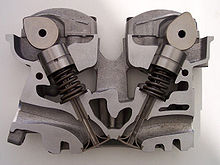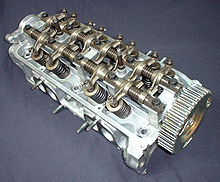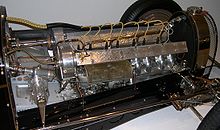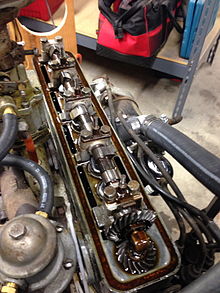Overhead camshaft engine: Difference between revisions
General editing, mostly in the DOHC section |
m Including motors that are NOT OHC is misleading as notes to this article. |
||
| Line 70: | Line 70: | ||
A '''double overhead camshaft'''<ref name=Hillier/><ref name=Stoakes/><ref name=PaulTan/> ('''DOHC''') valvetrain layout (also known as 'dual overhead camshaft') is characterised by two [[camshaft]]s located within the [[cylinder head]],<ref name=PaulTan/> one operating the intake valves and the other one operating the exhaust valves. This design reduces valvetrain inertia more than is the case with a SOHC engine, since the rocker arms are reduced in size or eliminated. A DOHC design permits a wider angle between intake and exhaust valves than do SOHC engines. This can allow for a less restricted airflow at higher engine speeds. DOHC with a [[multi-valve|multivalve]] design also allows for the optimum placement of the [[spark plug]] which, in turn, improves combustion efficiency.<ref name=PaulTan/> Engines having more than one [[cylinder bank|bank of cylinders]] (i.e. V6, V8 — where two cylinder banks meet to form a 'V') with two camshafts in total remain SOHC. Unless each cylinder bank has two camshafts, these latter are DOHC,<ref name=PaulTan/> and are often known as 'quad cam'. |
A '''double overhead camshaft'''<ref name=Hillier/><ref name=Stoakes/><ref name=PaulTan/> ('''DOHC''') valvetrain layout (also known as 'dual overhead camshaft') is characterised by two [[camshaft]]s located within the [[cylinder head]],<ref name=PaulTan/> one operating the intake valves and the other one operating the exhaust valves. This design reduces valvetrain inertia more than is the case with a SOHC engine, since the rocker arms are reduced in size or eliminated. A DOHC design permits a wider angle between intake and exhaust valves than do SOHC engines. This can allow for a less restricted airflow at higher engine speeds. DOHC with a [[multi-valve|multivalve]] design also allows for the optimum placement of the [[spark plug]] which, in turn, improves combustion efficiency.<ref name=PaulTan/> Engines having more than one [[cylinder bank|bank of cylinders]] (i.e. V6, V8 — where two cylinder banks meet to form a 'V') with two camshafts in total remain SOHC. Unless each cylinder bank has two camshafts, these latter are DOHC,<ref name=PaulTan/> and are often known as 'quad cam'. |
||
Although the term "twin cam" is often used to refer to a DOHC engine, it is imprecise, as it includes designs with two block-mounted camshafts. |
Although the term "twin cam" is often used to refer to a DOHC engine, it is imprecise, as it includes designs with two block-mounted camshafts. Examples include the [[Harley-Davidson Twin Cam engine]], [[Triumph Engineering|Triumph]] [[straight-twin engine|parallel-twins]] from the 1930s to the 1980s, and [[Indian Chief]] and [[Indian Scout (motorcycle)|Scout]] [[V-twin engine|V-twins]] from 1920 to the 1950s.</ref> |
||
The terms "multivalve" and "DOHC" are separate distinctions;<ref name=PaulTan/> not all multivalve engines are DOHC and not all DOHC engines are multivalve. Most recent DOHC engines are multivalve, with between three and five valves per cylinder. |
The terms "multivalve" and "DOHC" are separate distinctions;<ref name=PaulTan/> not all multivalve engines are DOHC and not all DOHC engines are multivalve. Most recent DOHC engines are multivalve, with between three and five valves per cylinder. |
||
Revision as of 04:11, 20 February 2015
This article needs additional citations for verification. (September 2007) |

Overhead camshaft,[1][2] commonly abbreviated to OHC,[1][2] is a valvetrain configuration which places the camshaft of an internal combustion engine of the reciprocating type within the cylinder heads ('above' the pistons and combustion chambers) and drives the valves or lifters in a more direct manner compared to overhead valves (OHV) and pushrods.
Overview
Compared to OHV pushrod systems with the same number of valves, the reciprocating components of the OHC system are fewer[1] and have a lower overall mass.[1] Though the system that drives the camshafts may be more complex, most engine manufacturers accept that added complexity as a trade-off for better engine performance and greater design flexibility. The fundamental reason for the OHC valvetrain is that it offers an increase in the engines' ability to exchange induction and exhaust gases. (This exchange is sometimes known as 'engine breathing'.[1] ) Another performance advantage is gained as a result of the better optimised port configurations made possible with overhead camshaft designs. With no intrusive pushrods, the overhead camshaft cylinder head design can use straighter ports[1] of more advantageous cross-section and length. The OHC design allows for higher engine speeds than comparable cam-in-block designs, as a result of having lower valvetrain mass. The higher engine speeds thus allowed increases power output for a given torque output.[1]
Disadvantages of the OHC design include the complexity of the camshaft drive, the need to re-time the drive system each time the cylinder head is removed, and the accessibility of tappet adjustment if necessary. In earlier OHC systems, including inter-war Morrises and Wolseleys, oil leaks in the lubrication systems were also an issue.[3]
Camshaft drive systems
All valve drive systems in four stroke engines must both power the valves and time their opening and closing. The OHC valvetrain system may be driven by the crankshaft using the same methods as an OHV system, but in practice (and depending on the application), lighter weight and maintenance-free methods are more commonly used.
Timing belt
This section needs expansion with: possibly merge main article into this section. You can help by adding to it. (January 2015) |
Toothed timing belt made from rubber and kevlar are commonly used to time overhead camshaft automobile engines.[1][4][5]
Timing chain
This section needs expansion with: examples and some history. You can help by adding to it. (January 2015) |
Duplex or single row roller chains have been used to drive overhead camshafts in automobile and motorcycle engines.[1][4][5]
Bevel shaft
This section needs expansion with: examples, inter-war Alfa Romeo, post-war Crosley, and several sports and racing motorcycles from the '20s to the '50s. You can help by adding to it. (January 2015) |
The use of a shaft with bevel gears to drive the camshaft was common in overhead camshaft designs before the Second World War.[citation needed] Examples include the Maudslay 25/30[6] built between 1908 and 1911,[7] the Bentley 3 Litre[8] and various racing motorcycles including the Velocette 'K' series[9] and the Norton Manx.[citation needed]
All Ducati single-cylinder OHC motorcycle engines used a bevel shaft system to drive the camshaft.[10] Some of their V-Twins also used bevel camshaft drive.[citation needed]
Gear train
This section needs expansion with: more examples and history. You can help by adding to it. (January 2015) |
Trains of timing gears are commonly used in diesel overhead camshaft engines used in heavy trucks.[11] They are less commonly used in overhead camshaft engines in light trucks or automobiles.[1]
Cranks and rods
British engineer J. G. Parry-Thomas developed a camshaft drive using three sets of cranks and rods in parallel.[12] Parry-Thomas used this drive system in the Leyland Eight.[13] W. O. Bentley used a similar system, called the "three-throw drive", in his six cylinder engines, the 6½ Litre and the 8 Litre.[13][14]
Variable valve timing
In conjunction with multiple valves (three, four or five) per cylinder,[1] many OHC engines today employ variable valve timing[1] to improve efficiency and power.[1]
Single overhead camshaft


Single overhead camshaft (SOHC)[1][4] is a design in which one camshaft is placed within the cylinder head.[1] In an inline engine, this means there is one camshaft in the head, whilst in an engine with more than one cylinder head, such as a V engine or a horizontally-opposed engine (boxer; flat engine) — there are two camshafts: one per cylinder bank.
In the SOHC design, the camshaft operates the valves directly, traditionally via a bucket tappet; or via an intermediary rocker arm.[1][4] SOHC cylinder heads are generally less expensive to manufacture than double overhead camshaft (DOHC) cylinder heads. Timing belt replacement can be easier since there are fewer camshaft drive sprockets that need to be aligned during the replacement procedure.

In the early era of the liquid-cooled aircraft engine field, single overhead camshaft format engines were in existence during the First World War, for both the Allies and the Central Powers. The Hispano-Suiza 8 — a V8 engine, designed by Marc Birkigt in the Allied camp, and the series of Mercedes inline-six aviation engines, culminating in the Mercedes D.III for the German Empire, both used rotary shaft-driven single overhead camshaft valvetrain systems, and were among the most prominent aviation powerplants of the First World War era. The late-war Liberty L-12 — a V12 engine configuration American aviation engine also used the general Mercedes D-series single overhead camshaft design, based primarily on the later D.IIIa's drive system from rocker box to valvestem.
SOHC designs offer reduced complexity compared to overhead valve designs — when used for multivalve cylinder heads, in which each cylinder has more than two valves. An example of an SOHC design using shim and bucket valve adjustment was the engine installed in the Hillman Imp (four cylinder, eight valve); a small, early 1960s two-door saloon car (sedan) with a rear mounted aluminium-alloy engine based on the Coventry Climax FWMA race engines. Exhaust and inlet manifolds were both on the same side of the engine block (thus not a crossflow cylinder head design). This did, however, offer excellent access to the spark plugs.
In the early 1980s, Toyota and Volkswagen Group[15] also used a directly actuated, SOHC parallel valve configuration with two valves for each cylinder. The Toyota system used hydraulic tappets, while the Volkswagen system used bucket tappets with shims for valve clearance adjustment. Of all valvetrain systems, this is the least complex configuration possible.
Unicam
A Unicam valvetrain is a Honda concept. This system uses one camshaft for each bank of cylinder heads, with the cams operating directly onto the inlet valve(s) and indirectly, through a short rocker arm, onto the exhaust valve(s). This allows a compact, light valvetrain to operate valves in a flat combustion chamber.[16] The Unicam valve train was first used in single cylinder dirt bikes,[17] and has been used on the Honda VFR1200 since 2010.[18]
Double overhead camshaft

A double overhead camshaft[1][2][4] (DOHC) valvetrain layout (also known as 'dual overhead camshaft') is characterised by two camshafts located within the cylinder head,[4] one operating the intake valves and the other one operating the exhaust valves. This design reduces valvetrain inertia more than is the case with a SOHC engine, since the rocker arms are reduced in size or eliminated. A DOHC design permits a wider angle between intake and exhaust valves than do SOHC engines. This can allow for a less restricted airflow at higher engine speeds. DOHC with a multivalve design also allows for the optimum placement of the spark plug which, in turn, improves combustion efficiency.[4] Engines having more than one bank of cylinders (i.e. V6, V8 — where two cylinder banks meet to form a 'V') with two camshafts in total remain SOHC. Unless each cylinder bank has two camshafts, these latter are DOHC,[4] and are often known as 'quad cam'.
Although the term "twin cam" is often used to refer to a DOHC engine, it is imprecise, as it includes designs with two block-mounted camshafts. Examples include the Harley-Davidson Twin Cam engine, Triumph parallel-twins from the 1930s to the 1980s, and Indian Chief and Scout V-twins from 1920 to the 1950s.</ref>
The terms "multivalve" and "DOHC" are separate distinctions;[4] not all multivalve engines are DOHC and not all DOHC engines are multivalve. Most recent DOHC engines are multivalve, with between three and five valves per cylinder.
History

Among the first cars to utilize engines with single overhead camshafts were the Maudslay designed by Alexander Craig and introduced in 1902[19] and the Marr Auto Car designed by Michigan native Walter Lorenzo Marr in 1903.[20][21] The first DOHC car was the 1912 Peugeot which won the French Grand Prix at Dieppe that year. This car was powered by a straight-4 engine designed by Ernest Henry under the guidance of the technically knowledgeable racing drivers Paul Zuccarelli and Georges Boillot. Boillot, who drove the winning car that year, won the French Grand Prix for Peugeot again in 1913 but was beaten in 1914 by the SOHC Mercedes of Christian Lautenschlager.
Among the early pioneers of DOHC were Isotta Fraschini's Giustino Cattaneo, Austro-Daimler's Ferdinand Porsche, Stephen Tomczak (in the Prinz Heinrich) (in 1919); Sunbeam built small numbers of racing models between 1921 and 1923 and introduced one of the world's first production twin cams in 1924 — the Sunbeam 3 litre Super Sports, an example of which came second at Le Mans in 1925.[22] The first DOHC engines were either two- or four-valve per cylinder racing car designs from companies like Fiat (1912), Peugeot Grand Prix (1912, four-valve), Alfa Romeo Grand Prix (1914, four-valve)[23] and 6C (1928), Maserati Tipo 26 (1926), Bugatti Type 51 (1931). and three years later, Harry A. Miller and Fred Offenhauser inaugurated the line of 4.1 litre DOHC Offenhauser inline-4 American auto racing engines, which began to dominate American open-wheel auto racing through much of the 20th century.
American luxury automaker Duesenberg was an early proponent of overhead camshaft engines with their SOHC straight eight Model A,[24] produced from 1921-1927. Duesenberg also produced successful OHC race car engines in the 1920s. The Duesenberg Model J, 1928-1937, featured a massive DOHC straight eight engine producing 265 horsepower.

Low-priced American manufacturer Crosley used a small, 44ci 4-cylinder SOHC engine following World War II. This unusual engine was developed during the war by Lloyd Taylor, licensed by Crosley, and used to power generators and other military applications. The overhead camshaft was driven by a tower shaft and gears. The original design was made of steel stampings, copper-brazed together to form a strong and light block assembly. It was known as the COBRA engine ("COpper BRAzed") and generated 26.5 hp in automotive form. (Jim Bollman. "Crosley Engine Family Tree - CoBra Years".)
Electrolysis and corrosion problems due to the bi-metallic construction of the Crosley engine and the salt-based antifreeze then in common use led to a more traditional cast iron block assembly (CIBA) version of the same engine in 1949. (Jim Bollman. "Crosley Engine Family Tree - CIBA Years".) Used in Crosley's Hot Shot sports car, this small OHC engine won the first 12 Hours of Sebring race in 1950. ("12 Hours of Sebring - Winners".) The Crosley OHC was popular in H-modified racing for its high-RPM performance. After Crosley ceased automotive production, the engine was produced by several other companies for many years, finishing its life as the Bearcat 55 outboard motor manufactured by Fisher Pierce, builders of the Boston Whaler boats. (Jim Bollman. "Crosley Engine Family Tree - Big Block Years".)
When DOHC technology was introduced in mainstream vehicles, it was common for it to be heavily advertised. While used at first in limited production and sports cars such as the 1925 Sunbeam 3 litre, Alfa Romeo is one of the twin cam's greatest proponents. 6C Sport, the first Alfa Romeo road car using a DOHC engine, was introduced in 1928. Ever since this, DOHC has been a trademark of most Alfa Romeo engines (some Alfa V6 engines are SOHC, not DOHC. Most Alfasud boxer engines were also SOHC).[23]
The Glas 1004, introduced in September 1961, had the first mass-produced engine to use a toothed belt to drive an overhead camshaft.[25] Fiat was one of the first car companies to use belt-driven DOHC engines in some of their products in the mid-1960s,[26] Jaguar's XK6 DOHC engine was displayed in the Jaguar XK120 at the London Motor Show in 1948, and used across the entire Jaguar range through the late 1940s, 1950 and 1960s. By the late 1970s, Toyota was the best seller of DOHC engines.[citation needed]
More than two overhead camshafts are not known to have been tried in a production engine. However, MotoCzysz has designed a motorcycle engine with a triple overhead camshaft configuration, with the intake ports descending through the cylinder head to two central intake ports between two outside exhaust camshafts actuating one of two exhaust valves per cylinder each.[27]

In inline piston aero engines, DOHCs have been used for many engines. The 1917 Napier Lion, for example, had them.
See also
Notes
References
- ^ a b c d e f g h i j k l m n o p q Hillier, V.A.W. (2012) [First published 1966]. "2". Fundamentals of Motor Vehicle Technology (Academic text-book). Vol. Book 1. In association with: The Institute of the Motor Industry (IMI) (6th ed.). Nelson Thornes Ltd. ISBN 9781408515181.
{{cite book}}:|access-date=requires|url=(help) - ^ a b c Stoakes, Graham; Sykes, Eric; Whittaker, Catherine (2011). "3". Principles of Light Vehicle maintenance & repair. Heinmann Work-Based Learning. Babcock International Group and Graham Stoakes. pp. 208–209. ISBN 9780435048167.
{{cite book}}:|access-date=requires|url=(help); Cite has empty unknown parameter:|summary=(help) - ^ Boddy, William (January 1964). Boddy, William (ed.). "Random Thoughts About O.H.C." Motor Sport. XL (1). London, UK: Teesdale Publishing: 15–18.
{{cite journal}}: Invalid|ref=harv(help) - ^ a b c d e f g h i Tan, Paul (22 June 2005). "SOHC vs DOHC Valvetrains: A Comparison". PaulTan.org. Driven Communications Sdn Bhd. Retrieved 29 August 2012.
- ^ a b "Dan's motorcycle 'Cam Drives'". dansmc.com. Retrieved 29 August 2012.
- ^ Boddy, William (August 1972). Boddy, William (ed.). "An Edwardian Overhead-Camshaft 25/30 Maudslay". Motor Sport. XLVIII (8). London, UK: Teesdale Publishing: 909. Archived from the original on 6 February 2015. Retrieved 6 February 2015.
{{cite journal}}: Invalid|ref=harv(help); Unknown parameter|deadurl=ignored (|url-status=suggested) (help) - ^ Culshaw, David; Horrobin, Peter (2013) [1974]. "Maudslay". The Complete Catalogue of British Cars 1895 - 1975 (e-book ed.). Poundbury, Dorchester, UK: Veloce Publishing. p. 210. ISBN 978-1-845845-83-4.
{{cite book}}: Invalid|ref=harv(help) - ^ Norbye, Jan P. (1981). The complete handbook of automotive power trains. Tab Books. p. 318. ISBN 0-8306-2069-9. LCCN 79026958. Retrieved 7 January 2015.
- ^ Cameron, Kevin (March 2004). "TDC: Little things". Cycle World. 43 (3): 14. ISSN 0011-4286. Retrieved 7 January 2015.
- ^ Walker, Mick (2003) [1991]. "4 Engine". Ducati Singles Restoration. St. Paul, MN US: Motorbooks International. p. 48. ISBN 0-7603-1734-8. Retrieved 4 January 2015.
{{cite book}}: External link in|chapterurl=|chapterurl=ignored (|chapter-url=suggested) (help) - ^ Bennett, Sean. Modern Diesel Technology: Diesel Engines. Stamford, CT US: Cengage Learning. pp. 88–89, 362. ISBN 978-1-285-44296-9. Retrieved 4 January 2015.
- ^ References:
- A US patent 1495620 A, John Godfrey Parry Thomas, "Internal Combustion Engine", issued 1924-05-27
- U.S. patent 1,495,620
- ^ a b Boddy, William (March 1974). Boddy, William (ed.). "How Did The Leyland Eight Rate?". Motor Sport. L (3): 230. Retrieved 3 January 2015.
- ^ Brooks, Philip C. (2009). Carpenter, Rhonda; Iwalani, Kahikina (eds.). "The Mighty Sixes". The International Club for Rolls-Royce & Bentley Owners Desk Diary 2010. Tampa, FL USA: Faircount: 27, 32.
{{cite journal}}: Invalid|ref=harv(help) - ^ ETKA
- ^ Lewis, Jimmy (November 2001). Edwards, David (ed.). "New for '02: Honda CR250R CRF450R". Cycle World. 40 (11). Hachette-Filipacchi Magazines: 62. ISSN 0011-4286. Retrieved 2 January 2015.
- ^ "How It Works: Honda Unicam® Engines". 23 January 2013. Archived from the original on 22 February 2014. Retrieved 2 January 2015.
{{cite web}}: Unknown parameter|deadurl=ignored (|url-status=suggested) (help) - ^ Cantin, Marc (19 October 2009). "2010 Honda VFR1200A First Ride". Moto123.com. Archived from the original on 2 January 2015. Retrieved 2 January 2015.
{{cite web}}: Unknown parameter|deadurl=ignored (|url-status=suggested) (help) - ^ References:
- Georgano, G. N. (1982) [1968]. "Maudslay". In Georgano, G. N. (ed.). The New Encyclopedia of Motorcars 1885 to the Present (Third ed.). New York: E. P. Dutton. p. 407. ISBN 0525932542. LCCN 81-71857.
{{cite encyclopedia}}: Invalid|ref=harv(help) - Culshaw & Horrobin 2013, p. 210
- Boddy 1972, p. 906
- Georgano, G. N. (1982) [1968]. "Maudslay". In Georgano, G. N. (ed.). The New Encyclopedia of Motorcars 1885 to the Present (Third ed.). New York: E. P. Dutton. p. 407. ISBN 0525932542. LCCN 81-71857.
- ^ Marr Auto Car Company
- ^ Kimes, Beverly Rae (2007). Walter L Marr: Buick's Amazing Engineer. Racemaker Press. p. 40. ISBN 0976668343.
- ^ Georgano, G.N. Cars: Early and Vintage, 1886-1930. (London: Grange-Universal, 1985).
- ^ a b Kevin Clemens (February 2009). "An Echo of the Past — the history and evolution of twin-cam engines". EuropeanCarWeb.com. European Car Magazine, Source Interlink Media. Retrieved 29 August 2012.
- ^ Mueller, Mike (2006). "Chapter 6 - Chariot of the Gods Duesenberg Straight Eight". American Horsepower 100 Years of Great Car Engines. St. Paul, MN USA: Motorbooks. p. 51. ISBN 978-0-7603-2327-4. LCCN 2006017040. Retrieved 2015-02-02.
{{cite book}}: External link in|chapterurl=|chapterurl=ignored (|chapter-url=suggested) (help) - ^ Norbye, Jan P. (1984). "Expanding on Excellence: The 5-Series and 3-Series". BMW - Bavaria's Driving Machines. Skokie, IL: Publications International. p. 191. ISBN 0-517-42464-9.
{{cite book}}: Invalid|ref=harv(help) - ^ "Old Fiat ad with Aurelio Lampredi". Retrieved 31 January 2015.
- ^ "Introducing MotoCzysz Z-Line 4 Engine". MotoCzysz. MotoCzysz.com. 2006-08-25. Retrieved 29 August 2012.
